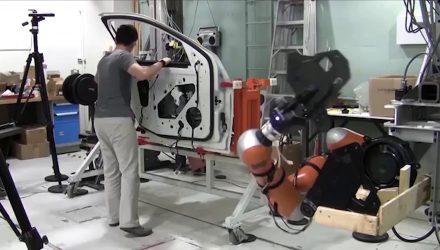The 3-Finger Gripper is one of our most iconic products. It turns up in groundbreaking robotic research projects all over the world, from search and rescue robots to assistive service robots. For researchers — and, indeed, non-researchers — it gives a good balance between ease-of-use and multi-fingered dexterity.
The problem with research, however, is that you always need to be on the bleeding edge of technology. You need to keep up with the newest robotic developments. You need to use the most up-to-date control algorithms to ensure that you’re not working on out-of-date technology.
Over the last 10 years, nothing has helped the spread of robotic technology more than ROS. Every day, it helps robotics researchers to avoid “reinventing the wheel” and gives them access to some of the most advanced functionality that is available.
We have just released our updated ROS package, which includes specific changes for our 3-Finger Gripper. Let’s have a look at what it is, what it includes, and what you can do with it.
What is the Deal with ROS?
In case you have somehow missed it, here’s a quick introduction to ROS.
Despite its name — which stands for “Robot Operating System — ROS is not an operating system. Instead, it is collection of software frameworks which sits on top of the operating system (primarily Linux). Through a set of basic packages, it provides the fundamental software required to run a robotic system.
The real power of ROS is that you can easily add advanced functionality to your robot by installing the relevant packages. You don’t have to fiddle around for hours trying to import libraries, decipher comments, and write wrapper-code, as you did in the past. Instead, you can access each package’s functionality via a set of standard messages without ever having to look at the underlying code. Our package means that you can get Robotiq products up-and-running with ROS very, very quickly.
Do I Need ROS?
This is a common question and the real answer is “It depends.”
If you want to use the 3-Finger Gripper for industrial applications, it’s possible that ROS is too complicated for your needs. If you’ve never used it before, ROS requires a bit of a learning curve and its third-party packages are not always stable enough for production environments (unless they’re marked as “production” in the ROS Industrial package — which no company has yet achieved).
If you are a researcher, however, our new ROS package is probably a good idea. It allows you to easily access the 3-Finger Gripper’s advanced functionality, as well as allowing you to control our other grippers and force sensor. See our eBook Adaptive Robot Grippers in Robotic R&D Projects for examples of what other research groups have achieved with the 3-Finger Gripper.
The Kinetic Release: How Distributions Work
Our updated package has been brought up-to-date for the Kinetic Kame LTS release of ROS, which was released in 2016.
